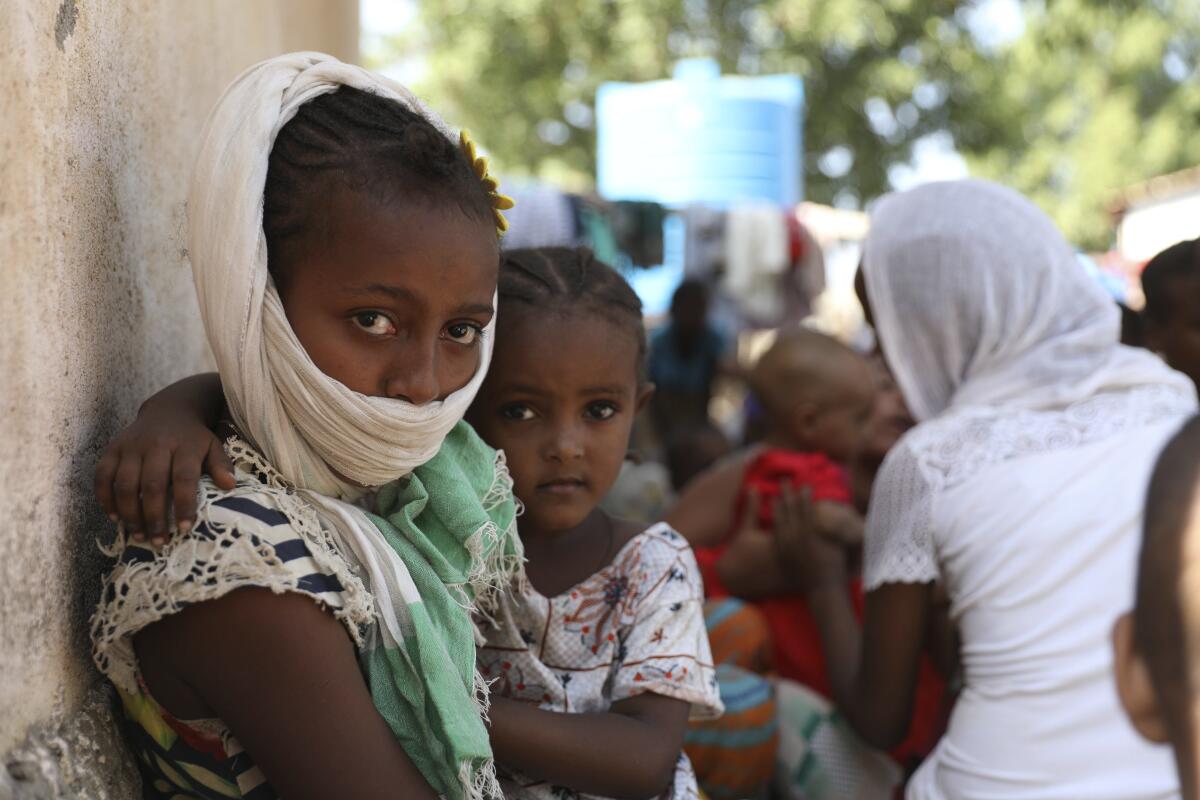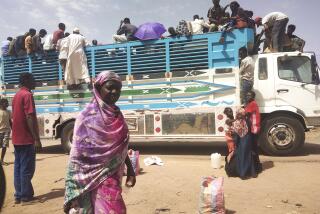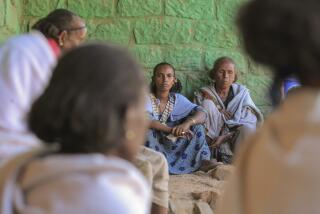As Ethiopia descends into civil war, civilians by the thousands begin to stream out

- Share via
NAIROBI, Kenya — The call from Ethiopia’s capital was grim. Four hundred and fifty miles north in the region of Tigray, Hiwot Araya’s hometown was about to be besieged.
A man from the town of Alamata had climbed to the top of a hill, searching for a signal amidst a government-imposed blackout. He managed to pass along accounts that the regional government — the Tigray People’s Liberation Front — had placed a tank outside the city, camouflaged in green. Ten buses had arrived to bus residents of Tigrayan ethnicity to safety, leaving thousands of worried residents behind.
If the man’s reports are true, “the government from Tigray is planning to burn the whole city today,” Hiwot told the Los Angeles Times. Rumors from the war zone are impossible to independently confirm. But Hiwot, a 31-year-old mother of two who fled to neighboring Kenya after her husband was killed by the TPLF four years ago, said she fears a similar fate could befall her uncle, her aunt and millions of others who find themselves caught in the crossfire in an emerging civil war between Ethiopia’s military and a well-armed adversary.
“I am hoping for peace,” said Hiwot. “But I worry a lot of lives will be lost. Not only my family, but for all people.”
On Nov. 4, Ethiopian Prime Minister Abiy Ahmed ordered airstrikes against targets in Tigray, a region in northern Ethiopia whose ethnic leaders led the country for nearly three decades before Ahmed was appointed in 2018. Ahmed, who just last year was awarded the Nobel Peace Prize, said he was left with no choice but to wage war after TPLF soldiers attacked Ethiopia’s military.
“Our law enforcement operations in Tigray are proceeding as planned: operations will cease as soon as the criminal junta is disarmed, legitimate administration in the region restored, and fugitives apprehended & brought to justice,” the prime minister wrote on Nov. 10.
By Friday night, some 22,000 refugees had fled from Tigray across the border to Sudan — half of them children, according to the United Nations High Commissioner for Refugees, which was preparing for as many as 100,000 refugees to arrive in days to come.
The backstory
Ethiopia is Africa’s second-most populous nation, and its northern Tigray region was already home to some 100,000 internally displaced people and another 96,000 refugees from neighboring Eritrea — half of the nation’s total, according to the UNHCR.
Tigray’s population of 6.5 million is predominantly farmers who grow wheat, barley, teff and sorghum, and raise cattle. Tourists sometimes pass through Tigray’s eastern tip en route to visit the nearby Danakil Depression, which many geologists and meteorologists regard as both the lowest and hottest place on earth, reaching 410 feet below sea level and with recorded temperatures as high as 125 degrees.
Despite Tigrayans accounting for just 6% of Ethiopia’s population, they dominated the nation’s politics for nearly three decades until Ahmed, a member of the ruling coalition of Oromo ethnicity, was appointed prime minister. Within months he brokered peace with neighboring Eritrea to end a violent, two-decades-long standoff between the nations.
But Tigrayans balked after Ahmed dissolved the ruling coalition to form a new political party, dismissed all the Tigrayans from his Cabinet, and postponed national elections scheduled for August. In September, Tigray held elections anyway, against orders from the capital.
In early November, Ethiopia’s Parliament labeled the TPLF a terrorist organization, complicating any attempt at negotiating peace. Ahmed said this month’s airstrikes were in retaliation for attacks by the TPLF that sought to steal weaponry and equipment from Ethiopia’s military and which left an unknown number of soldiers wounded and dead.
“We know there’s been federal aerial bombardment, but we don’t know the exact targets or how successful it’s been,” said William Davidson, senior Ethiopia analyst for the International Crisis Group.
Power and water have been cut to the region’s capital, Mekelle, home to nearly half a million people. Within hours of the airstrikes, reports surfaced that “a segment of the federal military was either forcefully taken over or defected to the Tigrayan side,” Davidson said — as many as 15,000 soldiers, by some accounts.
On Friday the TPLF fired rockets at two airports in federal government-held territory and on Saturday at least three rockets were aimed at an airport in the capital of Eritrea in an attempt by the TPLF to rope Ethiopia’s neighbor into the conflict. TPLF leadership has accused Eritrea, a longtime foe, of sending ground forces across the border to join the Ethiopian military in attacking Tigray.
Hundreds of soldiers on both sides are said to have been killed since the fighting began. Experts warn the conflict risks spoiling a delicate peace in the region and could escalate into a full-blown civil war.
A massacre of civilians / possible war crime
On Nov. 9, dozens if not hundreds of civilians were slashed with machetes and many were killed during a massacre in the town of Mai-Kadra in the southwest Tigray region, according to Amnesty International. Survivors, who hail from the Amhara ethnic group, said their attackers were members of the TPLF with whom they’d long scuffled over territory. The victims appeared to be day laborers who posed no discernible threat.
“TPLF commanders and officials must make clear to their forces and their supporters that deliberate attacks on civilians are absolutely prohibited and constitute war crimes,” said Amnesty International’s regional director Deprose Muchena, while the UN’s human rights chief warned that the killings may constitute “war crimes.”
“Ethnically motivated attacks and reportedly ethnic profiling of citizens constitute a dangerous trajectory that heightens the risk of genocide, war crimes, ethnic cleansing and crimes against humanity,” the UN warned. “There will be no winner in such a situation.”
The TPLF denied responsibility for the attacks.
Guilty or not, “the pinning of the massacre on the TPLF by the prime minister makes it even less likely that the government is going to pursue anything other than a military solution,” Davidson told The Times. “This reinforces the government narrative that they’re not fighting a war against some political opponent they fell out with, but that they’re fighting a war against a brutal junta that uses terrorism to maintain its power.”
On Saturday in the Ethiopian immigrant neighborhood Eastleigh in Nairobi, Kenya, men sat sipping Ethiopian coffee at sidewalk cafes as they scoured WhatsApp for messages and news from their homeland. Several told The Times that the conflict was liable to escalate as different ethnic militias chose their allegiances and prepared for battle.
“This thing is leading toward civil war,” said 33-year-old Tesfaye Diriba, member of an ethnic Oromo opposition political party who fled to Kenya after federal security forces raided his home and office and arrested his best friend in 2017.
“The solution, the way forward, is there should be a dialogue,” Diriba said. “If the war continues like this, it is inevitable that people will have to flee — flee to Somalia, Kenya, Sudan.”
Refugees flee to an unlikely place
Tens of thousands already have.
“They’re not coming with a lot of possessions, and this is the worry,” Axel Bisschop, a UNHCR representative in Sudan, told The Times on a call from Khartoum. “We are in need of everything — food, fresh water. We need to be prepared when it comes to COVID. We need more masks.”
He said rough terrain will make it difficult for aid and personnel to reach the remote region, and that resources for the refugees were already in short supply.
“We don’t have any place to house them. They’re sleeping in the open,” Bisschop said. He said it’s crucial that a camp be established far enough from the border to protect refugees from spillover fighting. But right now, “our priority is to make sure that the border remains open.”
“We are urging governments in the neighboring countries to keep their borders open for people forced from their homes,” said UNHCR Regional Bureau Director Clementine Nkweta-Salami. Refugee workers fear tens of thousands more people could flee if the conflict continues.
But Sudan can be a perilous place for ethnic minorities and people besieged by war. Its government has previously expelled humanitarian aid workers, nongovernmental organizations, human rights organizations and even UN officials.
Sudan’s government was responsible for a genocide that began in Darfur in 2003 and for long-standing aerial bombardments in nearby Blue Nile state, some 200 miles away, contributing to the forced displacement of some 2.4 million Sudanese.
“That area is prone to refugees,” Bisschop said — some 100,000 of them, according to the UNHCR. If precedent is any indication, the outlook for their swift and peaceful return to Ethiopia isn’t good.
“Eritrean refugees hosted there have been there for a very, very long time and are almost integrated into Sudan as such,” he said.
The conflict will put an additional strain on the global humanitarian aid sector, already burdened by the COVID-19 pandemic and inundated with more refugees than ever before. If the conflict becomes entrenched and the refugees are unable to return home, many may set their sights on asylum and hope for resettlement abroad.
Currently more than 250,000 Ethiopian immigrants and their children live in the United States — more than from any other African country except Nigeria. More live in California than any other state, with at least 7,000 in the Los Angeles metropolitan area.
Each year, the Ethiopian diaspora in the United States sends hundreds of millions of dollars in remittances back to Ethiopia. Totaling more than $3.8 billion, remittances from abroad account for 5% of Ethiopia’s gross domestic product — a figure that has stayed steady or risen despite the pandemic.
Experts warn that remittances may become more important than ever as the current conflict in Ethiopia gives way to extended economic hardship. Already in Tigray, “banking services have halted resulting in a lack of cash,” according to the UNHCR.
Internet and phone blackout leaves millions in the dark
Information about the conflict in Tigray is hard to come by, due in part to Ethiopia’s government-imposed blackout of phone and internet communication.
“Roads are blocked and electricity, phone and Internet are down, making communication nearly impossible,” the UNHCR said in a statement. Human rights groups and the UN have said such blackouts violate citizens’ basic right to information.
“The government must restore all communication to Tigray as an act of accountability and transparency for its military operations in the region,” Muchena said.
Ethiopian authorities have detained several journalists in recent months, including at least one who was reporting on the conflict in Tigray the day the fighting began. Press freedom watchdogs fear Ahmed’s blackout is meant to obscure information from reaching the public. Meanwhile, Ethiopia’s embassy in neighboring Kenya has yet to grant visas to journalists who wish to travel to Ethiopia to cover the emerging war.
Both sides seem poised to escalate the fighting. By some estimates the TPLF may have as many as 250,000 soldiers, many of them battle-hardened from years of fighting against Eritrea. Regional militias are said to be recruiting civilians as volunteer soldiers and collecting food and other provisions from residents.
On Saturday Ethiopia ordered thousands of its soldiers stationed in neighboring Somalia to come home, presumably to fight in the emerging war, according to reporting by Bloomberg.
“His true colors we are now starting to see,” said Abraham Barksa, a 47-year-old Ethiopian refugee in Nairobi from the same Oromo ethnicity as the prime minister. “He’s part of the problem. Abiy did not come for change.”
“Before fighting, they should have engaged in talks,” Fayisa Tolera, 43, a former Oromo Liberation Front soldier, told The Times. “For us, it’s not good. People are suffering, dying.”
Tolera cited rumors that Oromo and Tigrayan opposition forces — longtime enemies — are now joining forces against Ethiopia’s military. “Anybody who comes to our home to take, we are ready to defend ourselves.”
Despite reports that hundreds of soldiers from various sides have already been killed, experts worry it is Ethiopia’s civilians who will bear the brunt of war, just as they did in the town of Mai-Kadra.
“Is this mass killing a precursor for how this is going to play out? We sincerely hope not, but we can see the potential for increased inter-communal conflict in that area if Tigrayans end up defending their land against attempted Amhara annexation,” Davidson said, in reference to fears that ethnic or regional forces are taking advantage of the conflict to seize territory.
“There is increasing concern for the protection of civilians against hostilities,” the UN office that coordinates humanitarian assistance said in a statement. “Civilians caught in the crossfire always pay the price, especially children, women, elders and the disabled.”
Kushner is a special correspondent based in Nairobi. Reporting for this article was supported by a grant from the Pulitzer Center on Crisis Reporting.
More to Read
Sign up for Essential California
The most important California stories and recommendations in your inbox every morning.
You may occasionally receive promotional content from the Los Angeles Times.










